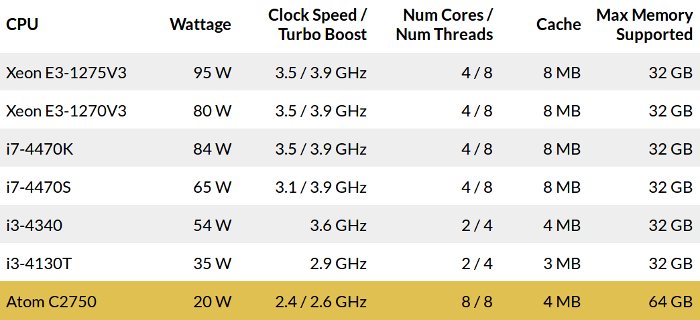
When the average person thinks about advances in computer processors, the general consensus is that faster is better. That makes sense right? Faster computers are better! If you talk to anyone who has ever worked in a data center though, they may have a somewhat different opinion.
Enterprise computing admins care about performance, absolutely, but they also often care about how much performance they get per watt of electricity used. Electricity costs money, especially when it's on data center scales - then there's the heat that servers generate and the amount of cooling you need to keep them running. The costs start to add up quickly.
Even small businesses can benefit from a power efficient server. There are cases where cloud based servers aren't appropriate for the application at hand, and a "traditional" server can be extremely noisy in a small office. One solution to this problem might be to use a desktop PC in a server role. What if, though, you could have a system that was designed to be a server but is just as quiet as a desktop PC and is even more energy efficient?
These are just a couple of the use cases for Intel's Atom based server chips. I'm not suggesting that data centers are going to replace all their high power servers with Atom based systems, but I'm also not suggesting that these new chips don't perform - they just don't measure up to today's top of the line CPUs. There are definite use cases though for a server with decent overall capability and that have an excellent performance / power ratio. Evidence of this can be seen over the last few years as servers based on low powered but with a high number of ARM CPU cores having become more popular. Intel would like a piece of that market, I'm certain.
I stumbled upon the existence of these low-power usage CPUs recently while browsing through NewEgg.com (something that I admit I probably do far too often ... I can shop for computer parts like my ex-wife could shop for shoes). They were released in Fall 2013, but you can't just buy these chips outright. Instead, they come embedded into server class mini-ITX motherboards. Yes I said mini-ITX form factor. Amazon & NewEgg have a couple boards featuring these chips retailing between $375 and $400. ASRock and SUPERMICRO both have come out with offerings - and both with different applications in mind. We'll take a look at those later on my next post.
CPU Specifications
First, let's have a look at the chip's specifications.
At first glance at the specs, the clock speed isn't bad but it's not going to win any contests. What should catch your attention though is that this CPU has a full 8 physical cores. Not 4 cores with hyperthreading - 8 actual cores. Additionally, supporting up to 64GB of ECC memory and Intel's VTx virtualization extensions. This chip was obviously designed with a purpose in mind.
CPU Comparison
But how well does this chip actually perform? I took a look at the CPU benchmark numbers for this chip and others on PassMark Software's cpubenchmark.net website and Intel's Ark and compiled some interesting information. Let's first take a look at the CPUs we'll be comparing.

These CPUs were chosen because they represent the fastest chips available at their respective wattage (Edit: at the time of writing). All of the comparison chips feature faster actual clock speeds than the C2750, but none of them feature the number of full cores and all at higher power requirements. Also interesting to note is that the Atom chip has support for twice the maximum memory as even the Xeons in the comparison.



This is where things get interesting. Just looking at the numbers, it's obvious every comparison chip has an overall higher benchmark score than the Atom. Notice the C2750's low single thread score. This is due to the reduced instruction set that the Atom has versus it's more "mainstream" cousins. It's overall score though is actually fairly decent. My still respectable though aging desktop with an AMD X4 635 scores over 500 points lower and uses 75 watts more power than the Atom.
Looking past the overall CPU performance, and focusing on the amount of performance you get per watt, none of the faster chips can compete. The closest competitor is the 65W i7-4770S - over 3 times the power required by the Atom. If your application doesn't require a lot of multithreading, such as your average desktop / workstation PC software, then the Atom is not for you. It was not designed for that purpose. Server tasks however are generally multithreaded in nature - especially when you get into virtualization. This is where the Atom C2750 will shine.
Summary
There are some obvious uses for systems with these chips. The most simple one is serving up files to a network. Businesses always have need for centralized storage solutions. I also envision systems running this chip being used with virtual systems like VMware ESXi or one of the many Linux based VM solutions (Xen, KVM) - especially running efficient Linux guests on them. Perhaps serving static HTML pages or functioning as a network appliance like a firewall or for load balancing in a high availability system. Of course, any responsible system admin is going to weigh their needs when evaluating any technology.
(I know I'd personally love to have one for hosting a GIT repository and a couple virtual systems for development and testing purposes. Perhaps someday.)
I want to say, thanks for reading! If you liked this post, stay tuned ... I'll be posting about some embedded boards featuring this chip and also a look at a full system configuration using these boards. Be sure to watch for them.
EDIT: - The board comparison is now online.

